what 4 people are need to fly military helicopter

An Mi-17 and troops, Afghanistan, 2009.
A military machine helicopter is a helicopter that is either specifically built or converted for utilise by military forces. A military helicopter's mission is a role of its design or conversion. The most common utilize of military helicopters is send of troops, but transport helicopters can be modified or converted to perform other missions such as combat search and rescue (CSAR), medical evacuation (MEDEVAC), airborne command post, or even armed with weapons for attacking ground targets. Specialized military helicopters are intended to comport specific missions. Examples of specialized military helicopters are attack helicopters, ascertainment helicopters and anti-submarine warfare helicopters.
Types and roles [edit]
Military helicopters play an integral part in the sea, land and air operations of modern militaries. More often than not manufacturers will develop airframes in unlike weight/size classes which can exist adapted to dissimilar roles through the installation of mission specific equipment. To minimise development costs the basic airframes tin be stretched and shortened, exist updated with new engines and electronics and take the entire mechanical and flying systems mated to new fuselages to create new aircraft. For example, the UH-1 has given ascent to a number of derivatives through stretching and re-engining, including the AH-one.
Modern helicopters take introduced modular systems which allow the same airframe to be configured for different roles, for case the EH-101 in Royal Navy service can exist quickly configured for ASW or send missions in hours. To at the aforementioned fourth dimension retain flexibility and limit costs, it is possible to fit an airframe for but non with a arrangement, for case in the U.s.a. Army'due south AH-64D variants are all fitted to be able to take the Longbow radar system, simply not enough sets accept been bought to equip the whole forcefulness. The systems tin can be fitted to only those airframes that demand it, or when finances allow the purchase of enough units.
Equipment [edit]
Near military helicopters are armoured to some extent; all the same, all equipment is express to the installed power and lift adequacy and the limits installed equipment places on useful payload. The most extensive armour is placed effectually the pilots, engines, transmission, and fuel tanks. Fuel lines, control cables and power to the tail rotor may also be shrouded past Kevlar armour. The about heavily armoured helicopters are attack, assault and special forces helicopters. In transport helicopters the coiffure compartment may or may not be fully armoured, a compromise beingness to give the passengers Kevlar lined seats merely to leave the compartment for the most role unarmoured. Survivability is enhanced by redundancy and the placement of components to protect each other. For example, the Blackhawk family of helicopters uses 2 engines and can continue to wing on simply one (nether sure weather), the engines are separated past the transmission and placed so that if attacked from any one flank, the engine on that flank acts to protect the transmission and the engine on the other side from impairment.
Aviation electronics, or avionics, such as communication radios and navigation aids are common on most military helicopters. Specialized avionics, such equally electronic countermeasures and identification friend or foe systems, are armed forces specific systems that can likewise be installed on armed forces helicopters. Other payload or mission systems are installed either permanently or temporarily, based on specific mission requirements; optical and IR cameras for lookout helicopters, dunking sonar and search radar for anti-submarine helicopters, extra radio transceivers and computers for helicopters used as airborne command posts.
Armour, burn suppression, dynamic and electronics systems enhancements are invisible to casual inspection; every bit a price-cutting measure some nations and services have been tempted to utilise what are essentially commercial helicopters for military machine purposes. For case, information technology has been reported that the PRC is conveying out a rapid enlargement of its assault helicopter regiments with the civilian version of the Mil Mi-17.[i] These helicopters without armour and electronic counter measures will role well enough for training exercises and photograph opportunities but would be suicidal to deploy in the set on role in actual combat situations. The intention of China appears to be to retrofit these helicopters with locally produced electronics and armour when possible, freeing available funds to allow rapid cosmos of enough regiments to equip each of its Group Armies, allowing a widespread buildup of experience in helicopter operations.
Assail [edit]
Assault helicopters are helicopters used in the anti-tank and close air support roles. The first of the modern set on helicopters was the Vietnam era AH-1 Cobra, which pioneered the at present classic format of pilot and weapons officer seated in tandem in a narrow fuselage, chin mounted guns, and rockets and missiles mounted on stub wings. To enable them to find and place their targets, some modern attack helicopters are equipped with very capable sensors[two] such as a millimeter wave radar organisation.
- Attack helicopters
-
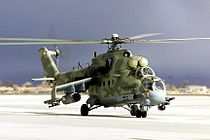
A Russian Mi-24P Hind-F large helicopter gunship and low-chapters troop send.
-
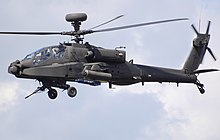
-

-

-

Ship [edit]
Transport helicopters are used for transporting personnel (troops) and cargo in support of military operations. In larger militaries, these helicopters are oft purpose-congenital for military machine operations, but commercially available shipping are also used. The do good of using helicopters for these operations is that personnel and cargo can be moved to and from locations without requiring a runway for takeoffs and landings. Cargo is carried either internally, or externally by slung load where the load is suspended from an attachment betoken underneath the shipping. Personnel are primarily loaded and unloaded while the helicopter is on the ground. However, when the terrain restricts even helicopters from landing, personnel may also be picked upwardly and dropped off using specialized devices, such as rescue hoists or special rope lines, while the aircraft hovers overhead.
Air set on is a military strategy that relies heavily on the utilise of send helicopters. An air assault involves a customized assault force that is assembled on the pick-upwards zone and staged for sequential transport to a landing zone (LZ). The idea is to utilize the helicopters to transport and state a large number of troops and equipment in a relatively short amount of fourth dimension, in club to assault and overwhelm an objective about the LZ. The advantage of air assault over an airborne assault is the ability of the helicopters to continually resupply the force during the performance, too as to transport the personnel and equipment to their previous location, or a follow-on location if the mission dictates.
- Transport helicopters
-

Mil Mi-17 ship of the Republic of kazakhstan government.[note 1]
-

UH-1D helicopters airlift members of a U.Due south. infantry regiment, 1966
-

A Mi-26 of the Russian Ministry for Emergency Situations
Observation [edit]
The first reconnaissance and observation aircraft were balloons, followed by calorie-free airplanes, such equally the Taylorcraft L-2 and Fieseler Fi 156. As the first military helicopters became available, their ability to both maneuver and to remain in ane location made them ideal for reconnaissance. Initially observation helicopters were express to visual observation by the aircrew, and most helicopters featured rounded, well-glazed cockpits for maximum visibility. Over time, the human eye became supplemented by optical sensor systems. Today, these include low calorie-free level tv set and forrad looking infrared cameras. Often, these are mounted in a stabilised mount forth with multi-function lasers capable of acting as laser rangefinder and targeting designators for weapons systems.[3]
By nature of the mission, the observation helicopter's primary weapons are its sensor suite and communications equipment. Early observation helicopters were effective at calling for artillery burn down and airstrikes. With modern sensor suites, they are also able to provide terminal guidance to ATGWs, light amplification by stimulated emission of radiation-guided bombs and other missiles and munitions fired by other armed aircraft.[4] [v] Observation helicopters may also be armed with combinations of gun and rocket pods and sometimes anti-tank guided missiles or air-to-air missiles, but in smaller quantities than larger attack helicopters.[six] Primarily, these weapons were intended for the counter-reconnaissance fight—to eliminate an enemy'southward reconnaissance avails—merely they can also exist used to provide limited direct fire support or close air support.
- Observation helicopters
-

An OH-58 Kiowa showing its mast mounted sight and a rocket pod.
-

Maritime [edit]
Amongst the offset applied uses of helicopters when the R-4 and R-5 became bachelor to Us and UK forces was deployment from navy cruisers and battleships, at showtime supplementing and afterward replacing catapult-launched observation aircraft. Another niche inside the capability of the early helicopters was every bit aeroplane guard - tasked with the recovery of pilots who had ditched about an aircraft carrier.
Equally helicopter applied science matured with increased payload and endurance, anti-submarine warfare (ASW) was added to the helicopter's repertoire. Initially, helicopters operated every bit weapons delivery systems, attacking with air-launched torpedoes and depth charges based on information provided by its parent and other warships. In the 1960s, the evolution of the turboshaft engine and transistor technology inverse the face of maritime helicopter aviation. The turboshaft engine allowed smaller helicopters, such as the Westland Wasp, to operate from smaller vessels than their reciprocating engine predecessors. The introduction of transistors immune helicopters, such every bit the SH-3 Sea Rex, to exist equipped with integral dunking sonar, radar and magnetic bibelot detection equipment. The result was an aircraft able to more than quickly reply to submarine threats to the fleet without waiting for directions from fleet vessels.
Today, maritime helicopters such as the SH-60 Seahawk and the Westland Lynx are designed to be operated from frigates, destroyers and similar size vessels. The desire to bear and operate 2 helicopters from frigate- and destroyer-sized vessels has affected the maximum size of the helicopters and the minimum size of the ships. Increasing miniaturisation of electronics, better engines and modern weapons at present let even the modern, destroyer-based, multi-function helicopter to operate nigh autonomously in the ASW, anti-shipping, transport, SAR and reconnaissance roles.
Medium- and large-sized helicopters are operated from carriers and land bases. In the British, Castilian, and Italian navies, the larger helicopters form the main anti-submarine forcefulness of carrier air wings. When operating from shore bases, the helicopters are used equally anti-submarine pickets to protect against hostile submarines loitering outside military machine ports and harbours; their endurance and payload providing advantages over smaller helicopters.
Soviet maritime helicopters, operating from its cruisers, had the additional role of guidance of the cruisers' long range anti-shipping missiles.
Maritime helicopters are navalised aircraft for performance from ships, this includes enhanced protection against salt water corrosion, protection against ingestion of water and provision for forced ditching at sea.
- Maritime helicopters
-

-

-
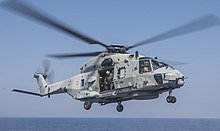
Multi-mission and rescue [edit]
As helicopters came into military service, they were quickly pressed into service for search and rescue[note two] and medical evacuation. During World War II, Flettner Fl 282s were used in Federal republic of germany for reconnaissance, and Sikorsky R-4s were used by the United States to rescue downed aircrews and injured personnel in remote areas of the China Burma India Theater, from April 1944 until the state of war's end. The use of helicopters for rescue during gainsay increased during the Korean War and the Algerian War. In the Vietnam State of war the USAF acquired Sikorsky S-61R (Jolly Dark-green Behemothic) and CH-53 Body of water Stallion (Super Jolly Green Behemothic) helicopters for the CSAR mission.[7]
- Multimission and Rescue helicopters
-

Bell 47 with patient transfer panniers.
-
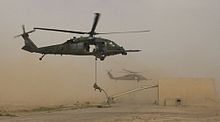
-
Preparation [edit]
Some services utilise a version of their operational helicopters, ordinarily in the light class, for pilot training. For instance, the British have used the Aérospatiale Gazelle both in operations and equally a trainer. Some services as well accept an Ab initio stage in training that uses very basic helicopters. The Mexican Navy has acquired a number of the commercially available Robinson R22[eight] and R44 helicopters for this purpose.
Utility [edit]
A utility helicopter is a multi-purpose helicopter. A utility military helicopter tin make full roles such equally ground assault, air set on, military logistics, medical evacuation, command and control, and troop transport.[9]
Tactics and operations [edit]
While non essential to combat operations, helicopters give a substantial advantage to their operators past being a force multiplier. To maximise their impact, helicopters are utilised in a combined arms approach.[10]
High intensity warfare [edit]

First generation Alouette anti-tank helicopter of the German Army armed with SS.x missiles
High-intensity warfare is characterized by large arrays of conventional armed forces, including mass formations of tanks, with significant air defenses. Helicopter armament and tactics were inverse to account for a less-permissive flying environment. Anti-tank missiles, such every bit the SS.11 and the Aérospatiale SS.12/Every bit.12 were adult and mounted on French military helicopters. In turn, the United states of america adjusted its BGM-71 TOW for firing from helicopters and somewhen developed the AGM-114 Hellfire. Meanwhile, the Soviet Union adapted the 3M11 Falanga missile for firing from the Mil Mi-24.

An OH-58 and an AH-1 of the Hawaii ARNG, such a combination would take formed hunter-killer team during the Cold War.[7]
In the air, assail helicopters armed with anti-tank missiles, and one or more unarmed, or lightly armed watch helicopters operate in concert. The scout helicopter, flying at low level in a nap-of-the-earth approach, attempts to both locate the enemy armoured columns and to map out approaches and deadfall positions for the assail helicopters. Late-model sentry helicopters include light amplification by stimulated emission of radiation designators to guide missiles fired from the attack helicopters. After finding a target, the lookout helicopter tin locate information technology and so direct the attack helicopter'southward missile where to fire. The attack helicopters have only to rise from embrace briefly to fire their missiles before returning to a concealed location.[7] Tardily-evolution of assail helicopters, such as the Mil Mi-28N, the Kamov Ka-52, and the AH-64D Longbow, incorporate sensors and command and command systems to relieve the requirement for scout helicopters.
To enhance the combat endurance of these missile-armed helicopters, transport helicopters were used to bear technicians, reloads and fuel to forward locations. Establishing these forward arming and refuel points (FARP) at pre-arranged locations and times immune armed or assault helicopters to re-arm and refuel, frequently with their engines running and the rotors still turning, and to rapidly return to the front lines.[seven]
Depression intensity warfare [edit]

In counter-insurgency (COIN) warfare, the government force establishes its presence in permanent or temporary war machine bases from which to mount patrols and convoys. The government forces seek to deter the insurgent forces from operating, and to capture or kill those that do. The operation of forces from stock-still bases linked by a stock-still network of roads becomes a weakness. Emplaced insurgents and local sympathisers may detect such facilities covertly and gather intelligence on the schedules and routes of patrols and convoys. With this intelligence the insurgents can time their operations to avoid the COIN forces or plan ambushes to engage them, depending on their ain tactical situation.
Helicopters render a measure of surprise and tactical flexibility to the COIN commander. Patrols need not start and cease in the same identify (the main archway of the local chemical compound), nor do supply convoys demand follow the same roads and highways. During the Rhodesian Bush War, the Rhodesian military machine developed and refined "Fireforce" tactics, using pocket-sized flights of light helicopters, the helicopters would be equipped as gunships to straight attack insurgents with aerial gunfire and also equally either an airborne command/observation post or troop transport. Once contact had been established against enemy guerillas paratroopers would be dropped by a Dakota and human action as "beaters" to drive the guerillas into finish groups landed by the helicopters.
During the Troubles, the Provisional Irish Republican Army (IRA) became adept at avoiding conventional, fixed roadblocks and patrols. To prevent predictable patterns, the patrols were deployed past helicopter, known as Hawkeye Patrols, and were then able to disrupt the IRA's power to move personnel and arms.[7] In the aftermath of the American invasion of Iraq helicopters have been used equally aeriform supply trucks and troop transports to foreclose exposure to ambushes prepare by the Iraqi insurgency.[xi]
Due to the cost and complexity of training and support requirements, insurgent forces rarely have access to helicopters.
Manufacturers [edit]

The major Western European helicopter manufacturers are now AgustaWestland and Eurocopter Group. In America, the three large remaining companies are Boeing (Boeing Vertol and McDonnell Douglas), Bell Helicopter and Sikorsky Aircraft.
In Japan the three main manufacturers of helicopters are the aviation artillery of the Japanese conglomerates Mitsubishi, Kawasaki and Fuji Heavy Industries. These companies initially followed a business model based on forming strategic partnerships with strange, ordinarily American, companies with the licensed production of those companies products, whilst edifice up their ain ability to pattern and industry helicopters through a procedure of workshare and technology transfer. In South asia, Indian Hindustan Helmsmanship Limited is the main helicopter manufacturer for the Indian Armed Forces.
In the Soviet-planned economical organization, the Mil and Kamov OKBs were responsible only for the pattern of helicopters. A re-arrangement of the helicopter manufacture in Russia created Russian Helicopters, a property visitor to bring together Mil, Kamov and helicopter manufacturing and maintenance plants.
See besides [edit]
- Air assail
- Armed helicopter
- Army aviation
- Helicopter bombing
Notes [edit]
- ^ Some members of the Mil Mi-8 family carry a substantial load of armament besides equally conveying troops.
- ^ Search and rescue is sometimes referred to as SAR. Search and rescue during combat is referred to by NATO countries as CSAR and is a specialized personnel recovery mission.
References [edit]
- ^ Kanwa Defense Review No26, "Is China'south 20-year build-upwardly Army Aviation Corps effective", February 2007.
- ^ Give us an enemy to fight, says chief of Britain'due south Apache helicopter fleet
- ^ Rotary Shipping:Doctrinal Evolution
- ^ OH-58D Kiowa Warrior Reconnaissance / Attack Helicopter, USA
- ^ Comanche'due south Child: The ARH-70 Armed Reconnaissance Helicopter
- ^ Filling Comanche's Shoes
- ^ a b c d e Cacutt, Len (1989). Gainsay. Aerospace Publishing Ltd. p. 185. ISBN1-55521-240-9.
- ^ Air Forces Monthly, February 2001, "Mexico Navy acquires Robinson R22s"
- ^ Farlex, Inc (2012). "Utility helicopter". Retrieved 10 Jan 2012.
- ^ Rotary Aircraft-Ground forces Plans
- ^ "Iraq fire downed US helicopters". BBC Online. iv Feb 2007. Retrieved 2007-ten-04 .
Further reading [edit]
- Boyne, Walter J. (2011). How the Helicopter Inverse Modern Warfare. Pelican Publishing. ISBNone-58980-700-6.
- FM 1-100 Army Aviation Operations from 21 February 1997 past Headquarters Section of the Regular army at GlobalSecurity.org
- FM 1-108 Doctrine For Army Special Operations Aviation Forces from iii November 1993 by Headquarters Department of the Regular army at GlobalSecurity.org
- FM 1–111 Aviation Brigades from 27 October 1997 past Headquarters Department of the Ground forces at GlobalSecurity.org
- FM ane-112 Attack Helicopter Operations from 2 Apr 1997 by Headquarters Department of the Army at GlobalSecurity.org
- FM i-113 Utility and Cargo Helicopter Operations from 25 June 1997 by Headquarters Department of the Regular army at GlobalSecurity.org
- FM 1-114 Air Cavalry Squadron and Troop Operations from one Feb 2000 past Headquarters Department of the Army at GlobalSecurity.org
- FM ane-120 Army Air Traffic Service Contingency and Gainsay Zone Operations from 22 May 1995 by Headquarters Department of the Army at GlobalSecurity.org
- FM 1-140 Helicopter Gunnery from 29 March 1996 by Headquarters Department of the Regular army at GlobalSecurity.org
- FM 3-04.500 Army Aviation Maintenance from 26 September 2000 by Headquarters Section of the Ground forces at GlobalSecurity.org
- FM xc-4 Air Assault Operations from sixteen March 1987 by Headquarters Department of the Regular army at GlobalSecurity.org
External links [edit]
- Army Aviation Clan of America
- Homepage of the Imperial Navy's Fleet Air Arm
- Homepage of the UK's Regular army Air Corps
- Helicopter folio from RAF homepage
- French Ministry of Defence ALAT page
- CombatAircraft.com - Helicopters
Source: https://en.wikipedia.org/wiki/Military_helicopter
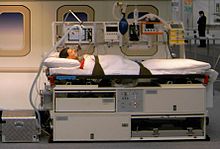
0 Response to "what 4 people are need to fly military helicopter"
Post a Comment